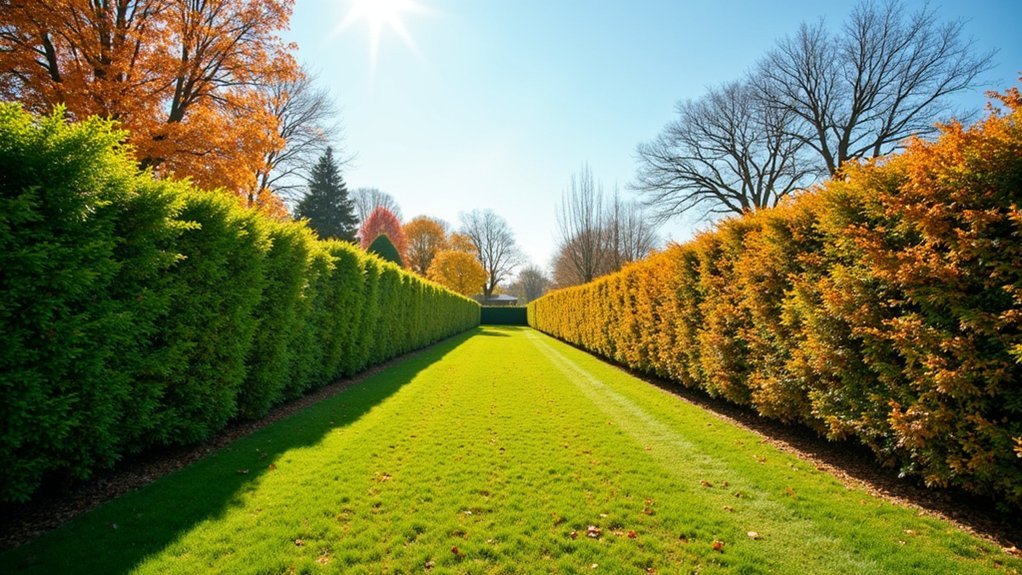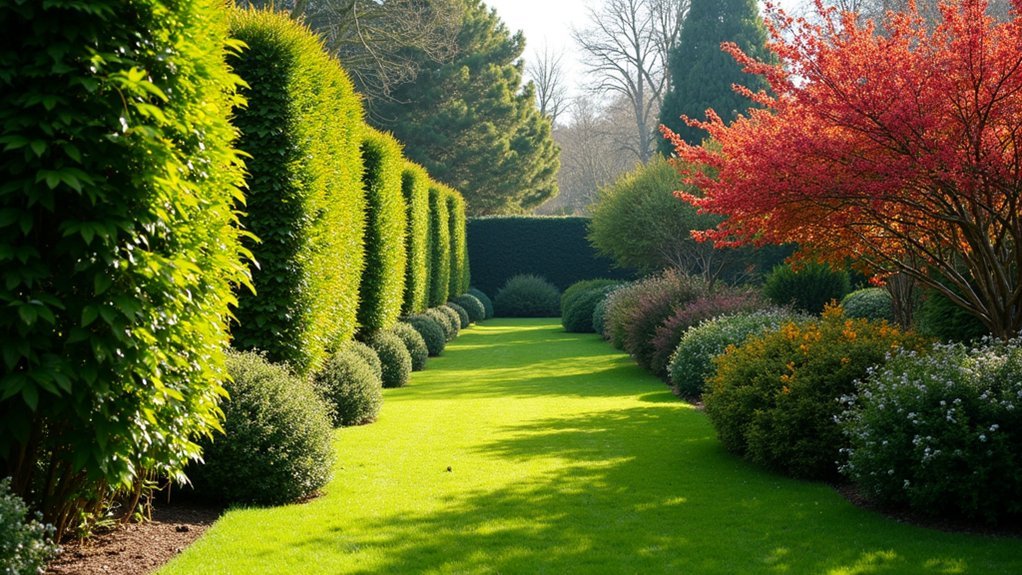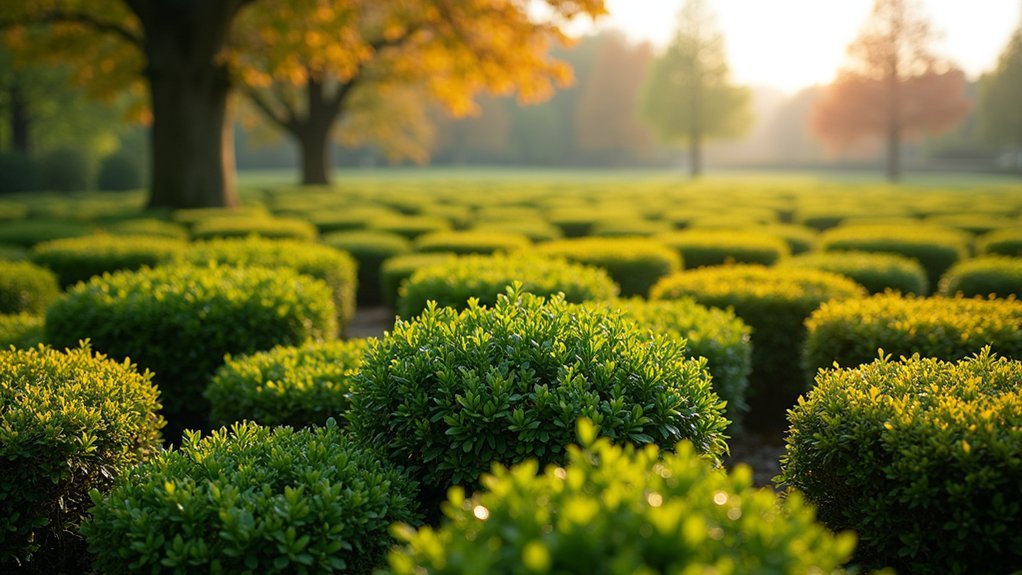Hedge laying is best performed between October and March when plants are dormant. You’ll find winter ideal as leafless branches reveal the hedge structure, making stem selection easier. Different species have specific timing preferences – hawthorn and blackthorn thrive when laid February-March, while hazel benefits from November-February work. Always stop if you discover nesting birds, typically from mid-March onward. The seasonal window provides perfect conditions for regeneration, with rich results awaiting those who time it right.
When to Lay Hedges: Complete Seasonal Guide

Although hedge laying is a traditional skill that requires proper technique, timing is equally essential for successful results.
Mastering hedge laying demands not just skill but perfect seasonal timing for truly effective outcomes.
You’ll want to perform hedge laying between October and March when hedging plants are dormant. This window allows for easier manipulation and guarantees healthy root development when the plants reestablish.
If you need to plant new hedges, remember that rising sap begins mid-March, making earlier work generally preferable for most species. However, hedge maple may actually lay better slightly later in the season.
Always check for nesting birds before your hedge needs attention, as work must stop immediately if you discover nests.
While you can continue laying until the end of April if you’ve started before March ends, respecting wildlife regulations protects local bird populations.
The Optimal Winter Window for Traditional Hedge Laying
While many gardening tasks pause during winter, these colder months represent prime time for traditional hedge laying. October to March offers ideal conditions to begin hedge laying, as plants are dormant and less likely to suffer stress during this essential maintenance.
For best results, start your hedge laying projects early in the winter window when:
- Leafless branches reveal the hedge’s structure clearly, making it easier to select which stems to cut and lay
- Stakes and bindings are readily available, simplifying your preparation process
- Old hedges benefit from optimal regeneration conditions when laid during dormancy
- Newly planted sections can be incorporated seamlessly into gaps, strengthening the overall hedge
This traditional winter timing guarantees your hedge will thrive once spring growth begins.
Early Spring Considerations and Limitations for Hedge Work

Once March arrives, hedge layers face a narrowing window of opportunity as nature begins its seasonal shift.
By mid-March, rising sap makes certain species more difficult to lay, requiring you to adjust your plans accordingly.
As sap rises mid-March, hedge layers must adapt their approach to accommodate nature’s seasonal rhythms.
You’ll need to inspect hedges carefully for nesting birds before starting any hedge work, as EEC legal regulations protect these habitats.
If you find no nests, you can proceed, but aim to complete your project before April ends.
Remember to document your inspection by filling out a compliance form with your start date and bird check results.
Some species like hedge maple actually benefit from late spring laying due to their unique sap patterns.
Bird Nesting Seasons and Regulatory Compliance
As spring advances, bird nesting season becomes the primary determining factor for hedge laying activities.
While you can legally continue hedge laying until late April, you must adhere to EEC regulations protecting bird habitats.
Before starting any work, conduct and document thorough checks for nesting birds.
- Mid-March typically marks the beginning of bird nesting season across most UK regions
- If you discover nests during hedge laying, all work must halt until September
- Local knowledge is essential as nesting seasons vary by region
- DEFRA guidelines require completion of documentation stating start date, time, and confirmation of nest checks
Remember to have your client sign the compliance form, demonstrating your commitment to regulatory adherence.
This seasonal guide helps guarantee your hedge laying activities respect both wildlife conservation efforts and legal requirements.
Species-Specific Timing for Different Hedge Plants

Different hedge species require specific timing for ideal laying results, since each plant’s dormancy cycle and sap flow patterns vary considerably.
For hawthorn and blackthorn, the best time to plant is February to March when sap levels decrease and dormancy guarantees better recovery.
Field maple offers more flexibility, thriving when laid from late autumn through early spring.
Field maple’s adaptable nature allows for successful laying across multiple seasons, from autumn’s first chill through spring’s awakening.
Hazel hedges benefit from species-specific timing between November and February, when stems reach peak pliability while promoting growth from the base.
For vibrant dogwood, schedule laying in February to encourage robust new growth as the root system awakens.
Yew hedges can be successfully laid from late autumn until early spring, but you’ll need to monitor light conditions carefully, stopping before mid-March when sap begins rising.
With proper timing, each variety offers the finest hedging results.
Frequently Asked Questions
What Is the Best Month to Plant a Hedge?
You’ll have the best results planting hedges in early spring (March-April) or late autumn (October-November). These cooler periods allow roots to establish before summer heat or winter cold arrives.
What Time of Year Do You Lay a Hedge?
You should lay hedges during the dormant season, from October to March. If you start before March ends, you can continue until late April. Always check for nesting birds after mid-March as they’re beginning to appear.
What Time of Year Should I Move My Hedge?
Move your hedge during its dormant period, from late autumn to early spring. For deciduous hedges, choose late autumn after leaf fall. For evergreens, early spring works best. Avoid moving during active growth seasons.
What Is the Best Season to Trim Hedges?
The best season to trim hedges is late winter or early spring before new growth begins. You’ll also benefit from summer pruning to maintain shape, but you should avoid fall trimming to prevent winter damage.
In Summary
Time your hedge laying precisely for best results. You’ll achieve the strongest regrowth by working during the winter dormancy period when sap flow is minimal. Always respect the March-August nesting season restrictions to protect wildlife and comply with regulations. Remember that different hedge species respond better to specific timing windows. With proper seasonal planning, you’ll create healthier, more vibrant hedgerows that thrive for decades.





Leave a Reply